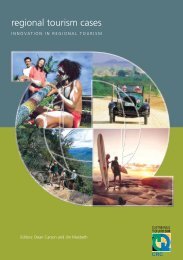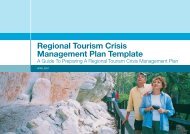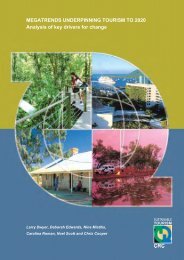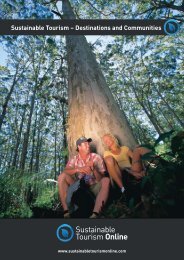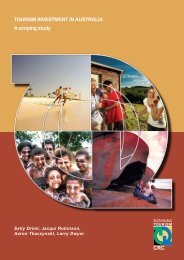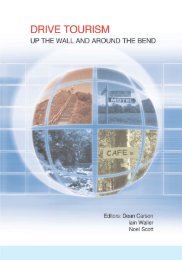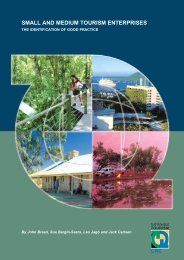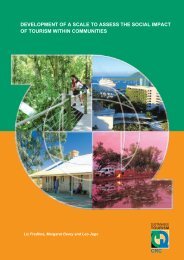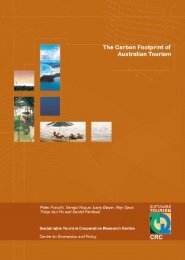Tourism Risk Management - Sustainable Tourism Online
Tourism Risk Management - Sustainable Tourism Online
Tourism Risk Management - Sustainable Tourism Online
Create successful ePaper yourself
Turn your PDF publications into a flip-book with our unique Google optimized e-Paper software.
epresentatives. While all initial enquiries were directed to this coordination centre, smaller centres<br />
were also established in hospitals and affected provinces. Volunteers assisted at the EOC, medical<br />
facilities and the airport, while accommodation and service providers donated food, shelter and<br />
support for victims and emergency responders.<br />
In the high profile tourist resort of Patong most utilities were restored within days and the beach was<br />
quickly cleared of debris. With rapid evacuations and an initial distribution of resources, issues of<br />
food, water and sanitation never became a real threat for tourists. Yet, as repetitive images and<br />
stories of the disaster continued to dominate the media, most of the world was left with the<br />
impression that the entire island of Phuket had been devastated and blanket travel advisories were<br />
implemented. Disease and health epidemics related to stagnant water bodies and unrecovered<br />
corpses were seen as probable risks to travellers. Despite the influx of trained personnel, finances,<br />
resources and medical aid from around the globe, it proved difficult to relay credible information. As<br />
response efforts moved from search and rescue endeavours to further medical assistance, victim<br />
identification, repatriation, trauma/grief support and initial damage assessments, few authorities<br />
seemed willing to comment on popular speculation regarding a subsequent tsunami.<br />
Local businesses, many of which lacked insurance, were left to consider future options and<br />
business viability. Where possible, stock was recovered, sold at discounted prices or restored to<br />
former condition. As hotels, buildings and resorts were fenced from public view and looting, debris<br />
accumulated in the street for removal by government and private-enterprise-sponsored contractors.<br />
While struggling with personal grief and loss, the community, all sectors of business, industry, and<br />
government worked together to restore the operational capacity and image of Patong and other less<br />
affected regional resorts. The national government offered official support and compensation for all<br />
direct victims. A conference hosted in Phuket by the World <strong>Tourism</strong> Organization and international<br />
industry experts developed the Phuket Action Plan to assist and guide the restoration of tourism<br />
throughout the affected regions<br />
Rebuilding and Recovery<br />
With occupancy rates recorded below 40% within the first nine months following the incident,<br />
recovery has strongly focused on emotional support, physical reconstruction, safety and greater<br />
tourism sustainability. A subsequent earthquake (yet no resultant tsunami) on 28 March 2005 was<br />
sufficient to demonstrate a residual fear regarding this hazard. Consistent with the United Nations<br />
resolution to develop an Indian Ocean Tsunami Warning System, Thailand embarked on its own<br />
public warning system, complete with a string of coastal warning towers. With scheduled training<br />
evacuations, practice drills and improved local hazard awareness education, Thailand has strived to<br />
actively promote the message that it values the lives of both residents and tourists.<br />
Organized journalist trips and high profile celebrity visits have also been staged to emphasize a<br />
return to conditions of safety and security. Extensive recovery plans implemented between the<br />
government, community and industry have sought to address many of the medium- and long-term<br />
issues associated with both tourism development and the tsunami including; environmental<br />
encroachment, water quality monitoring, resource use, and the proximity of structures to the<br />
coastline. While international arrival figures over the first anniversary of the tsunami (coinciding with<br />
a traditional peak tourist season) were encouraging for most, they were short of the optimistic<br />
predictions of full industry recovery.<br />
Given the scale and severity of the disaster, the Andaman region has yet to fully recover<br />
economically yet, in terms of response and consumer confidence initiatives, this region has<br />
demonstrated relative success in its crisis management capacity. Awareness, local hazard<br />
education and communication may have been improved, however, all stakeholders have since<br />
become proactively involved in mitigation efforts and making the tourism product and destination<br />
more resilient to future adversity.<br />
(Source: Phuket Gazette, 2006; Wikipedia, 2006; and UNWTO, 2006)<br />
34 <strong>Tourism</strong> <strong>Risk</strong> <strong>Management</strong> – An Authoritative Guide to Managing Crises in <strong>Tourism</strong>



